Abstract
In cultured rat hepatocytes, cystine led to an inhibition of GSH efflux by lowering the Vmax by approximately 35% without affecting the Km. The cystine-mediated inhibition of GSH efflux was rapid in onset (< 1 h), with near maximum effect at 0.1 mM. Inhibition was still observed when cystine uptake was prevented. Cystine and sulfobromophthalein-GSH, a selective inhibitor of sinusoidal transport of GSH, did not exhibit additive inhibitory effects on GSH efflux. Depletion of ATP or membrane depolarization after cystine treatment were excluded as potential mechanisms. DTT not only reversed the cystine-mediated inhibition of GSH efflux, it stimulated GSH efflux up to 400-500%. The DTT effect was immediate in onset, reaching maximum after 30 min, and was partially reversed by cystine, suggesting that the two share a common site(s) of action. DTT treatment did not alter cellular ATP levels or change the membrane potential. In cultured hepatocytes, DTT treatment increased the Vmax of GSH efflux by approximately 500% without affecting the Km. Inhibition of microtubular function and vesicular acidification did not affect basal or DTT stimulated efflux. Both cystine and DTT effects on sinusoidal GSH efflux were confirmed in perfused livers. In summary, the capacity of the sinusoidal GSH transporter is markedly influenced by thiol-disulfide status.
Full text
PDF
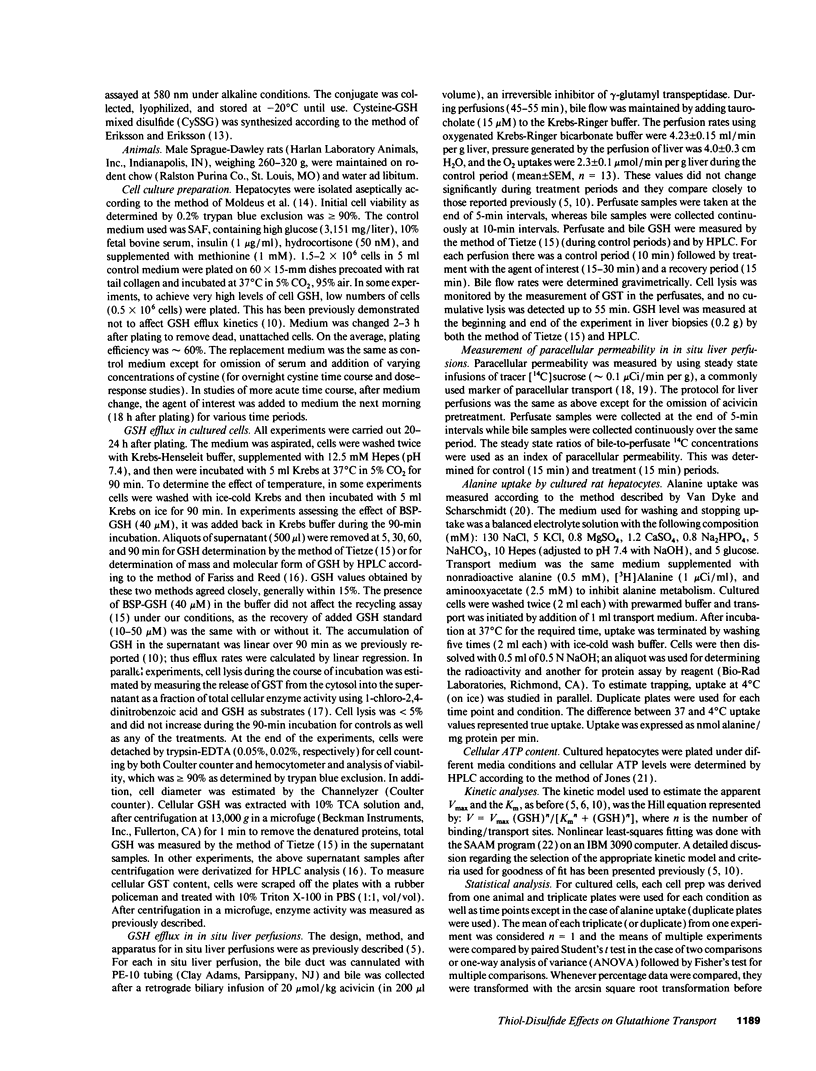
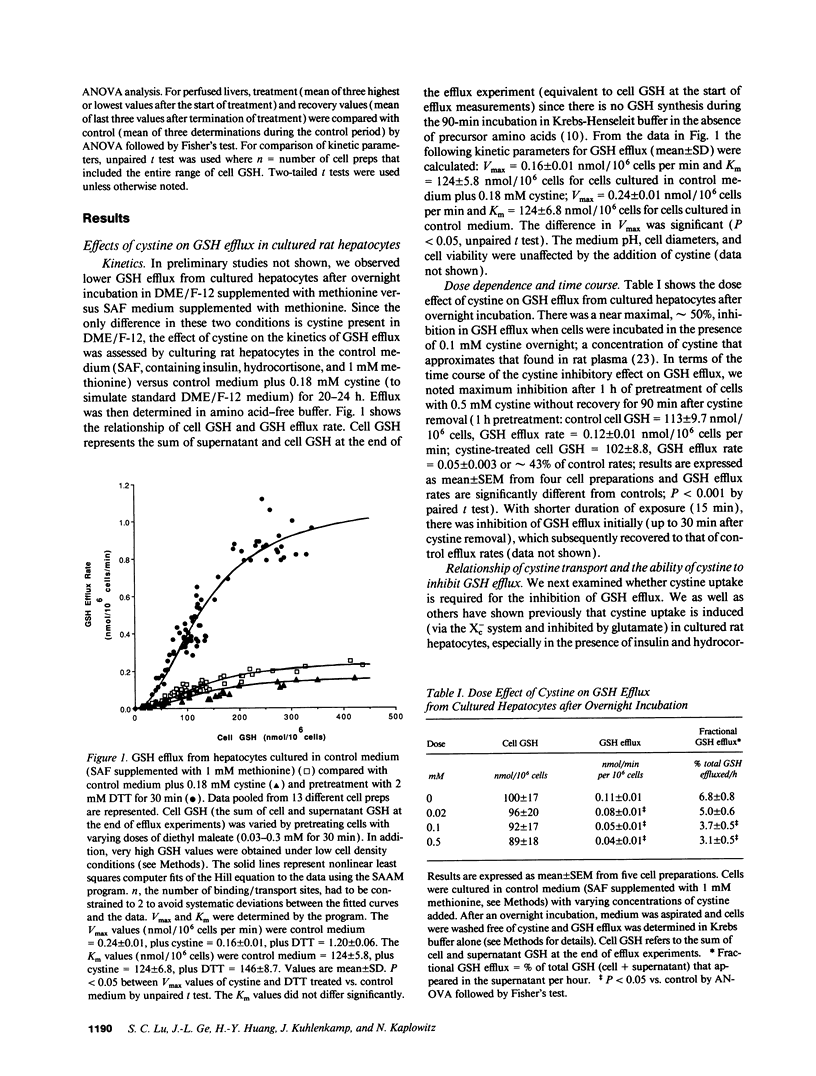
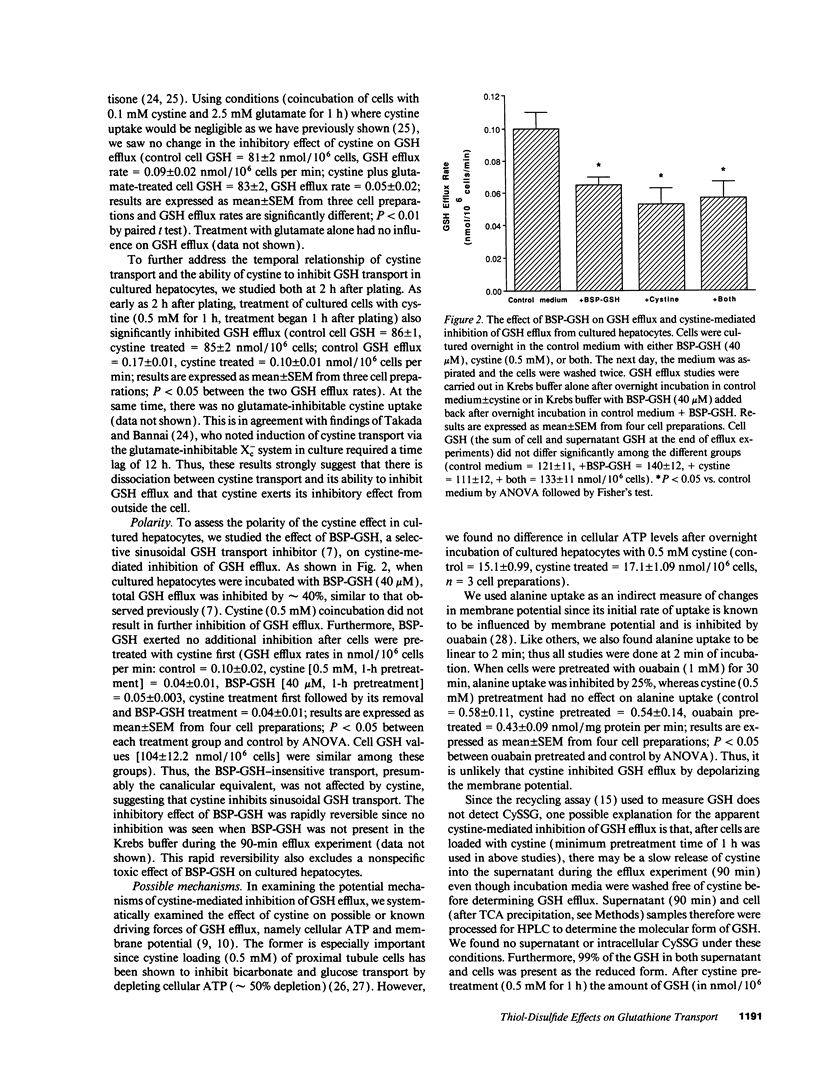
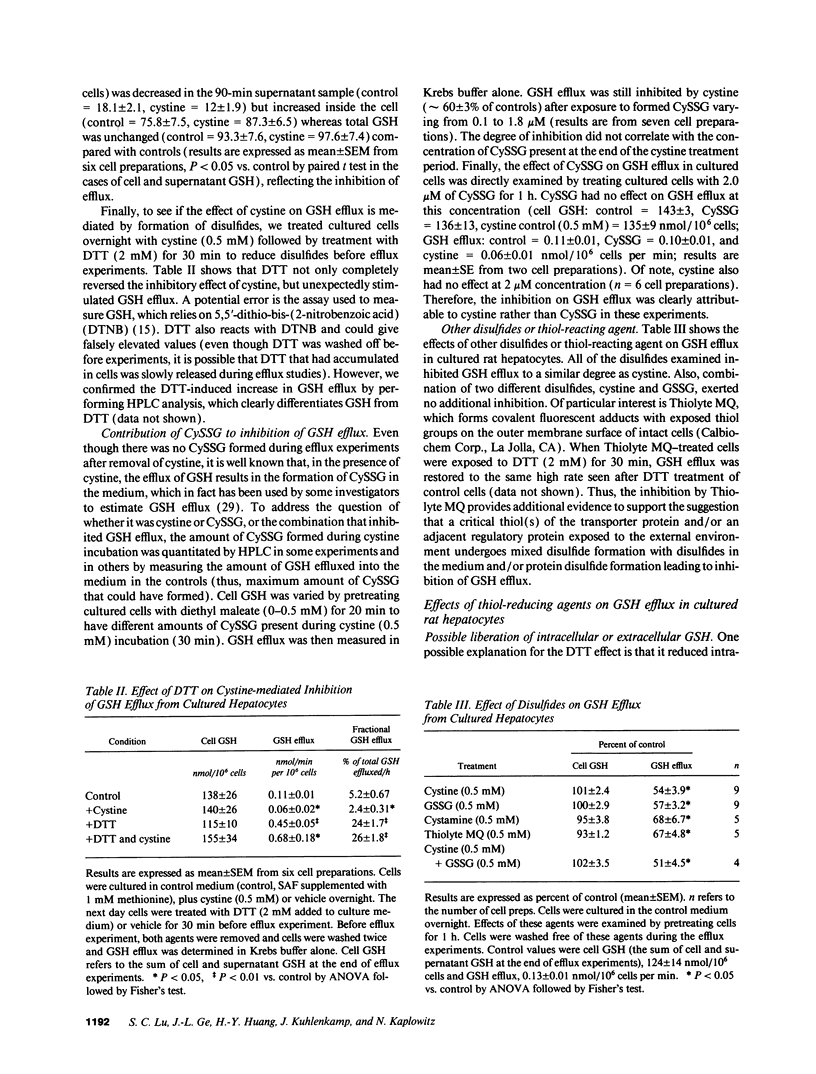
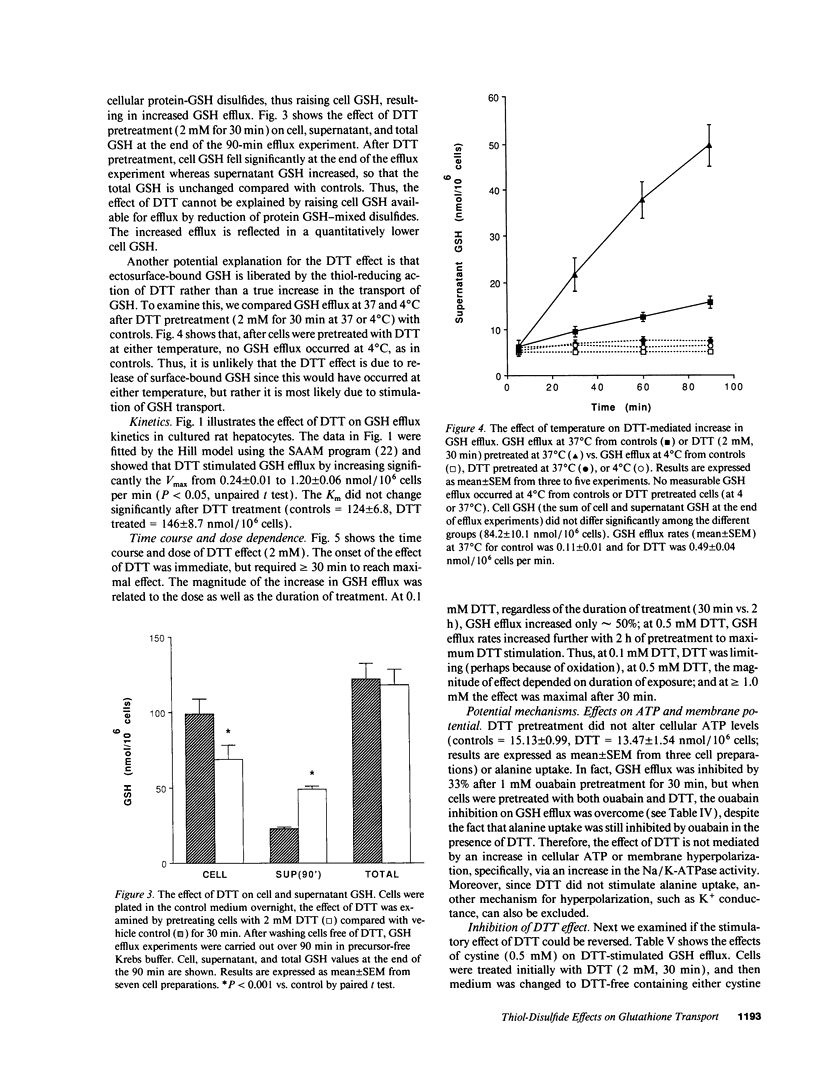
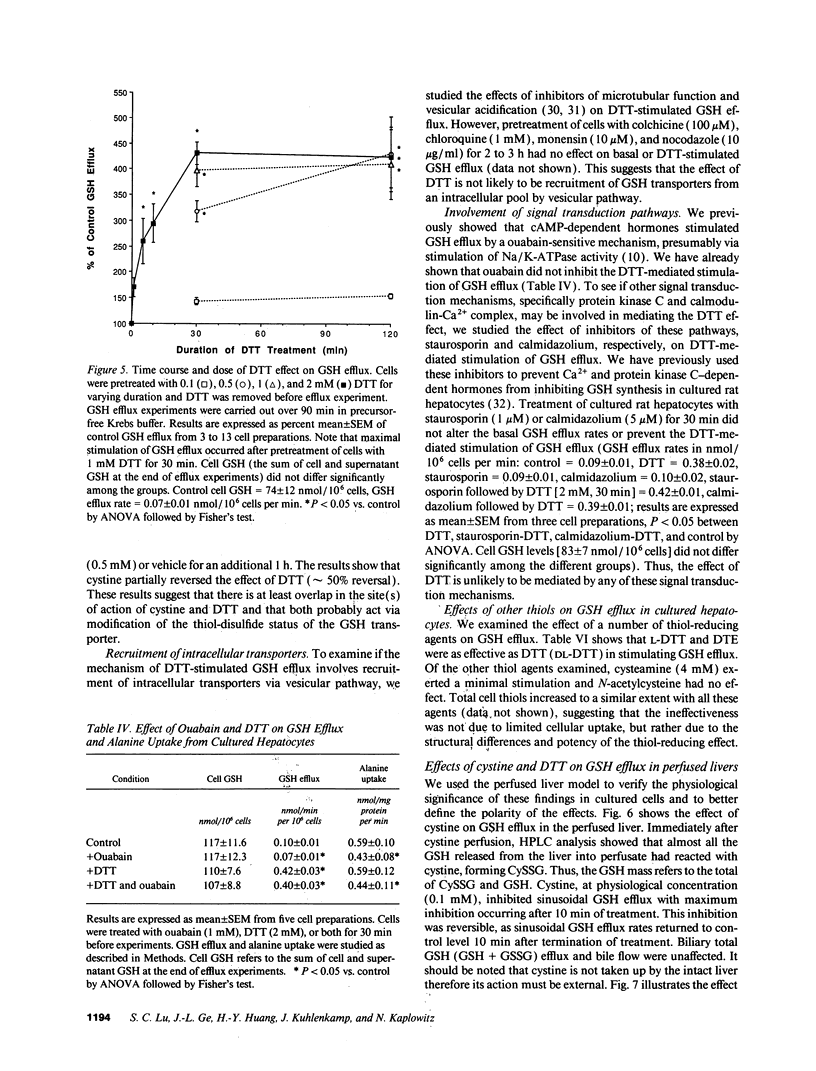
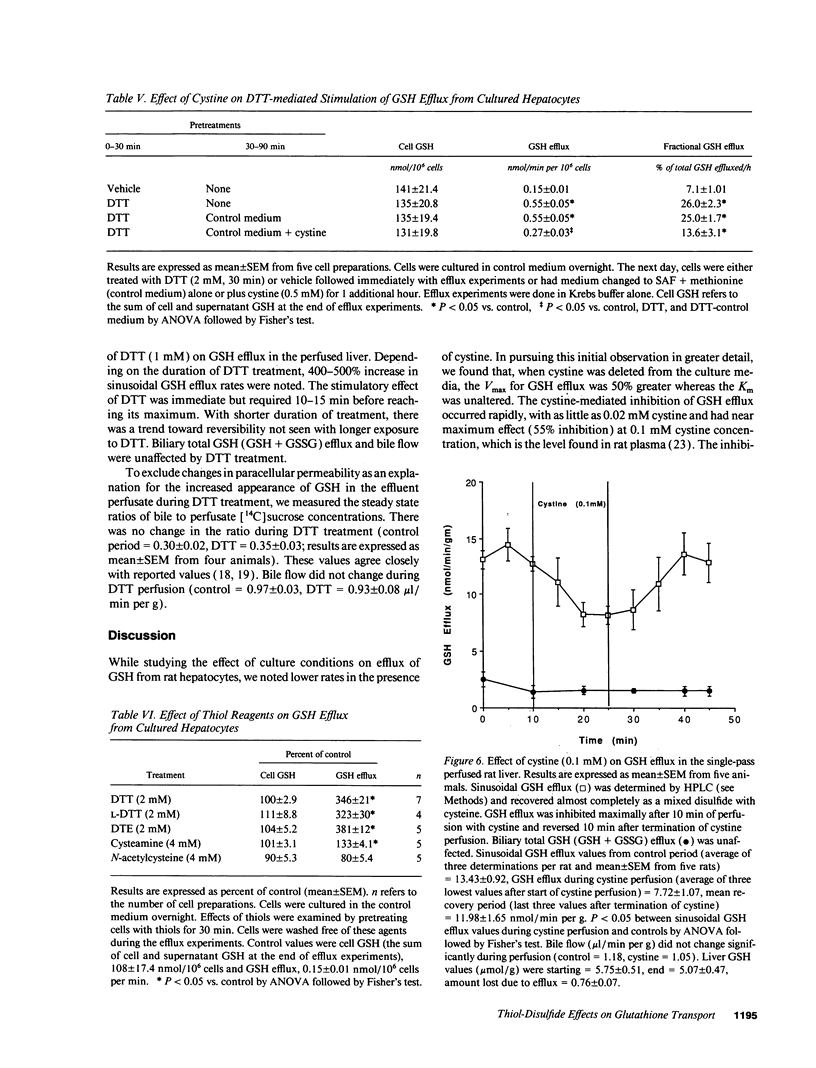
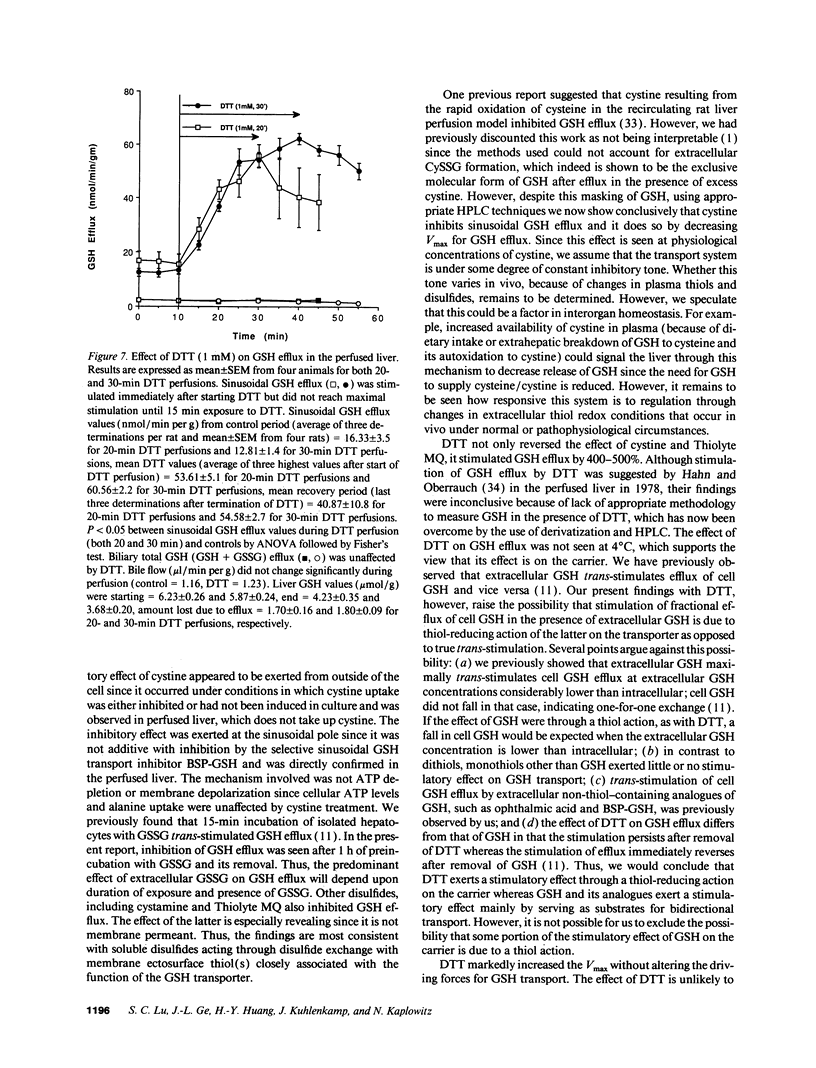
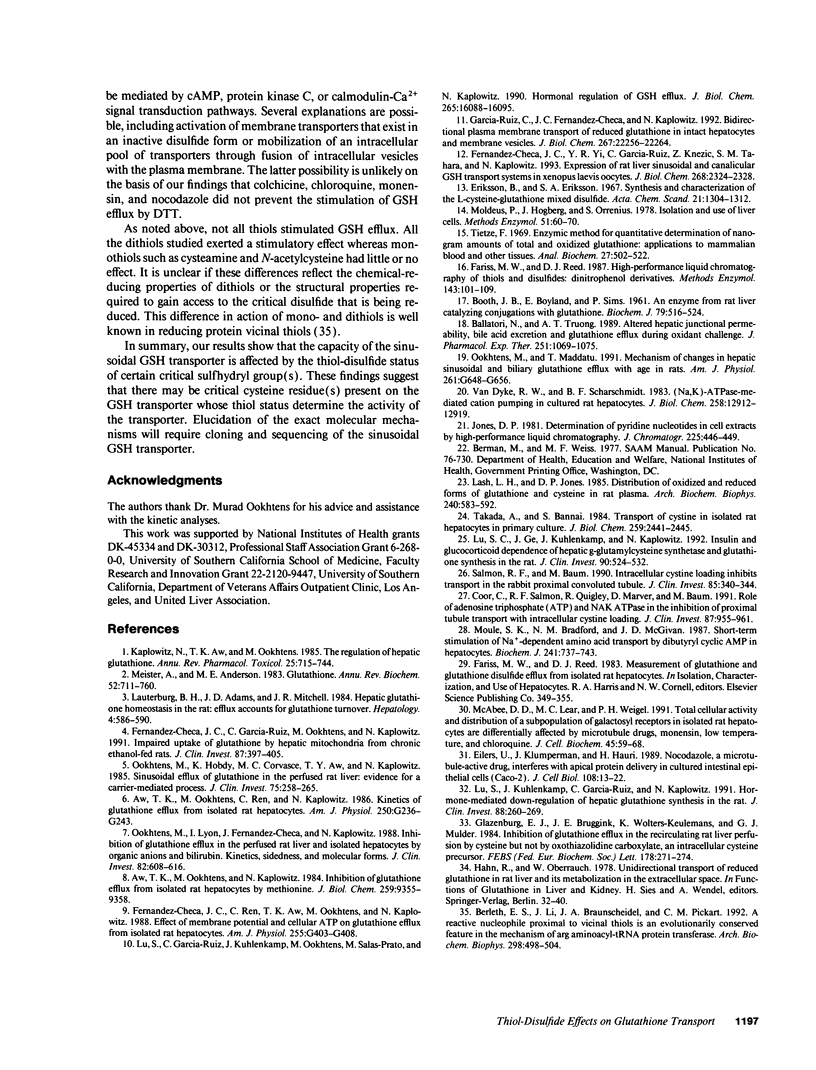
Images in this article
Selected References
These references are in PubMed. This may not be the complete list of references from this article.
- Aw T. Y., Ookhtens M., Kaplowitz N. Inhibition of glutathione efflux from isolated rat hepatocytes by methionine. J Biol Chem. 1984 Aug 10;259(15):9355–9358. [PubMed] [Google Scholar]
- Aw T. Y., Ookhtens M., Ren C., Kaplowitz N. Kinetics of glutathione efflux from isolated rat hepatocytes. Am J Physiol. 1986 Feb;250(2 Pt 1):G236–G243. doi: 10.1152/ajpgi.1986.250.2.G236. [DOI] [PubMed] [Google Scholar]
- Ballatori N., Truong A. T. Altered hepatic junctional permeability, bile acid excretion and glutathione efflux during oxidant challenge. J Pharmacol Exp Ther. 1989 Dec;251(3):1069–1075. [PubMed] [Google Scholar]
- Berleth E. S., Li J., Braunscheidel J. A., Pickart C. M. A reactive nucleophile proximal to vicinal thiols is an evolutionarily conserved feature in the mechanism of Arg aminoacyl-tRNA protein transferase. Arch Biochem Biophys. 1992 Nov 1;298(2):498–504. doi: 10.1016/0003-9861(92)90441-x. [DOI] [PubMed] [Google Scholar]
- Booth J., Boyland E., Sims P. An enzyme from rat liver catalysing conjugations with glutathione. Biochem J. 1961 Jun;79(3):516–524. doi: 10.1042/bj0790516. [DOI] [PMC free article] [PubMed] [Google Scholar]
- Coor C., Salmon R. F., Quigley R., Marver D., Baum M. Role of adenosine triphosphate (ATP) and NaK ATPase in the inhibition of proximal tubule transport with intracellular cystine loading. J Clin Invest. 1991 Mar;87(3):955–961. doi: 10.1172/JCI115103. [DOI] [PMC free article] [PubMed] [Google Scholar]
- Eilers U., Klumperman J., Hauri H. P. Nocodazole, a microtubule-active drug, interferes with apical protein delivery in cultured intestinal epithelial cells (Caco-2). J Cell Biol. 1989 Jan;108(1):13–22. doi: 10.1083/jcb.108.1.13. [DOI] [PMC free article] [PubMed] [Google Scholar]
- Eriksson B., Eriksson S. A. Synthesis and characterization of the L-cysteine-glutathione mixed disulfide. Acta Chem Scand. 1967;21(5):1304–1312. doi: 10.3891/acta.chem.scand.21-1304. [DOI] [PubMed] [Google Scholar]
- Fariss M. W., Reed D. J. High-performance liquid chromatography of thiols and disulfides: dinitrophenol derivatives. Methods Enzymol. 1987;143:101–109. doi: 10.1016/0076-6879(87)43018-8. [DOI] [PubMed] [Google Scholar]
- Fernandez-Checa J. C., Ren C., Aw T. Y., Ookhtens M., Kaplowitz N. Effect of membrane potential and cellular ATP on glutathione efflux from isolated rat hepatocytes. Am J Physiol. 1988 Oct;255(4 Pt 1):G403–G408. doi: 10.1152/ajpgi.1988.255.4.G403. [DOI] [PubMed] [Google Scholar]
- Fernández-Checa J. C., García-Ruiz C., Ookhtens M., Kaplowitz N. Impaired uptake of glutathione by hepatic mitochondria from chronic ethanol-fed rats. Tracer kinetic studies in vitro and in vivo and susceptibility to oxidant stress. J Clin Invest. 1991 Feb;87(2):397–405. doi: 10.1172/JCI115010. [DOI] [PMC free article] [PubMed] [Google Scholar]
- Fernández-Checa J. C., Yi J. R., Garcia-Ruiz C., Knezic Z., Tahara S. M., Kaplowitz N. Expression of rat liver reduced glutathione transport in Xenopus laevis oocytes. J Biol Chem. 1993 Feb 5;268(4):2324–2328. [PubMed] [Google Scholar]
- García-Ruiz C., Fernández-Checa J. C., Kaplowitz N. Bidirectional mechanism of plasma membrane transport of reduced glutathione in intact rat hepatocytes and membrane vesicles. J Biol Chem. 1992 Nov 5;267(31):22256–22264. [PubMed] [Google Scholar]
- Glazenburg E. J., Bruggink J. E., Wolters-Keulemans K., Mulder G. J. Inhibition of glutathione efflux in the recirculating rat liver perfusion by cysteine but not by oxothiazolidine carboxylate, an intracellular cysteine precursor. FEBS Lett. 1984 Dec 10;178(2):271–274. doi: 10.1016/0014-5793(84)80614-6. [DOI] [PubMed] [Google Scholar]
- Jones D. P. Determination of pyridine dinucleotides in cell extracts by high-performance liquid chromatography. J Chromatogr. 1981 Oct 9;225(2):446–449. doi: 10.1016/s0378-4347(00)80293-5. [DOI] [PubMed] [Google Scholar]
- Kaplowitz N., Aw T. Y., Ookhtens M. The regulation of hepatic glutathione. Annu Rev Pharmacol Toxicol. 1985;25:715–744. doi: 10.1146/annurev.pa.25.040185.003435. [DOI] [PubMed] [Google Scholar]
- Lash L. H., Jones D. P. Distribution of oxidized and reduced forms of glutathione and cysteine in rat plasma. Arch Biochem Biophys. 1985 Aug 1;240(2):583–592. doi: 10.1016/0003-9861(85)90065-7. [DOI] [PubMed] [Google Scholar]
- Lauterburg B. H., Adams J. D., Mitchell J. R. Hepatic glutathione homeostasis in the rat: efflux accounts for glutathione turnover. Hepatology. 1984 Jul-Aug;4(4):586–590. doi: 10.1002/hep.1840040402. [DOI] [PubMed] [Google Scholar]
- Lu S. C., Garcia-Ruiz C., Kuhlenkamp J., Ookhtens M., Salas-Prato M., Kaplowitz N. Hormonal regulation of glutathione efflux. J Biol Chem. 1990 Sep 25;265(27):16088–16095. [PubMed] [Google Scholar]
- Lu S. C., Ge J. L., Kuhlenkamp J., Kaplowitz N. Insulin and glucocorticoid dependence of hepatic gamma-glutamylcysteine synthetase and glutathione synthesis in the rat. Studies in cultured hepatocytes and in vivo. J Clin Invest. 1992 Aug;90(2):524–532. doi: 10.1172/JCI115890. [DOI] [PMC free article] [PubMed] [Google Scholar]
- Lu S. C., Kuhlenkamp J., Garcia-Ruiz C., Kaplowitz N. Hormone-mediated down-regulation of hepatic glutathione synthesis in the rat. J Clin Invest. 1991 Jul;88(1):260–269. doi: 10.1172/JCI115286. [DOI] [PMC free article] [PubMed] [Google Scholar]
- McAbee D. D., Lear M. C., Weigel P. H. Total cellular activity and distribution of a subpopulation of galactosyl receptors in isolated rat hepatocytes are differentially affected by microtubule drugs, monensin, low temperature, and chloroquine. J Cell Biochem. 1991 Jan;45(1):59–68. doi: 10.1002/jcb.240450113. [DOI] [PubMed] [Google Scholar]
- Meister A., Anderson M. E. Glutathione. Annu Rev Biochem. 1983;52:711–760. doi: 10.1146/annurev.bi.52.070183.003431. [DOI] [PubMed] [Google Scholar]
- Moldéus P., Högberg J., Orrenius S. Isolation and use of liver cells. Methods Enzymol. 1978;52:60–71. doi: 10.1016/s0076-6879(78)52006-5. [DOI] [PubMed] [Google Scholar]
- Moule S. K., Bradford N. M., McGivan J. D. Short-term stimulation of Na+-dependent amino acid transport by dibutyryl cyclic AMP in hepatocytes. Characteristics and partial mechanism. Biochem J. 1987 Feb 1;241(3):737–743. doi: 10.1042/bj2410737. [DOI] [PMC free article] [PubMed] [Google Scholar]
- Ookhtens M., Hobdy K., Corvasce M. C., Aw T. Y., Kaplowitz N. Sinusoidal efflux of glutathione in the perfused rat liver. Evidence for a carrier-mediated process. J Clin Invest. 1985 Jan;75(1):258–265. doi: 10.1172/JCI111682. [DOI] [PMC free article] [PubMed] [Google Scholar]
- Ookhtens M., Lyon I., Fernandez-Checa J., Kaplowitz N. Inhibition of glutathione efflux in the perfused rat liver and isolated hepatocytes by organic anions and bilirubin. Kinetics, sidedness, and molecular forms. J Clin Invest. 1988 Aug;82(2):608–616. doi: 10.1172/JCI113639. [DOI] [PMC free article] [PubMed] [Google Scholar]
- Ookhtens M., Maddatu T. Mechanism of changes in hepatic sinusoidal and biliary glutathione efflux with age in rats. Am J Physiol. 1991 Oct;261(4 Pt 1):G648–G656. doi: 10.1152/ajpgi.1991.261.4.G648. [DOI] [PubMed] [Google Scholar]
- Salmon R. F., Baum M. Intracellular cystine loading inhibits transport in the rabbit proximal convoluted tubule. J Clin Invest. 1990 Feb;85(2):340–344. doi: 10.1172/JCI114443. [DOI] [PMC free article] [PubMed] [Google Scholar]
- Takada A., Bannai S. Transport of cystine in isolated rat hepatocytes in primary culture. J Biol Chem. 1984 Feb 25;259(4):2441–2445. [PubMed] [Google Scholar]
- Tietze F. Enzymic method for quantitative determination of nanogram amounts of total and oxidized glutathione: applications to mammalian blood and other tissues. Anal Biochem. 1969 Mar;27(3):502–522. doi: 10.1016/0003-2697(69)90064-5. [DOI] [PubMed] [Google Scholar]
- Van Dyke R. W., Scharschmidt B. F. (Na,K)-ATPase-mediated cation pumping in cultured rat hepatocytes. Rapid modulation by alanine and taurocholate transport and characterization of its relationship to intracellular sodium concentration. J Biol Chem. 1983 Nov 10;258(21):12912–12919. [PubMed] [Google Scholar]



